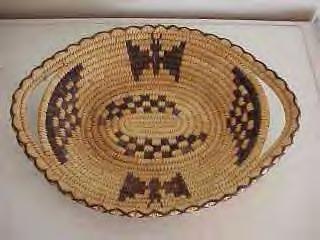|
|
Canku Ota |
|
|
(Many Paths) |
||
|
An Online Newsletter Celebrating Native America |
||
|
October 20, 2001 - Issue 47 |
||
|
|
||
|
Baskets Hold Cultural, Artistic Link to the Past |
||
|
by Rhina Guidos Reno Gazette-Journal - Saturday September 29th, 2001 |
 Thousands
of years ago, American Indians used baskets to carry seeds, to cook and to transport water across vast distances.
But on Friday, to mark National American Indian Day, the Reno Sparks Indian Colony celebrated baskets as the receptacles
of cultural pride. Thousands
of years ago, American Indians used baskets to carry seeds, to cook and to transport water across vast distances.
But on Friday, to mark National American Indian Day, the Reno Sparks Indian Colony celebrated baskets as the receptacles
of cultural pride.“I’m glad we’re here today on ancestral lands,” said Arlan Melendez , chairman of the colony. “We’re here to welcome you in this show of unity, doing something that goes back thousands of years, something that gives us a sense of identity.” This weekend, more than 100 American Indian basket makers share their cultural, artistic and historical world of baskets at the Great Basin Native Basketweavers Gathering at Reno-Sparks Indian Colony. Robert Baker, Jr., chairman of the basket weaver group, said the free event is for anyone wanting to learn about and share American Indian culture. “Our gathering will offer some great activities and events that will strengthen our cultural ties among all attending,” he said. Some like novice basket weaver Audencio Zarate, of Reno, attended the event to admire the art form but also to learn about history through the baskets. “It’s a beautiful experience,” Zarate said. “It’s an expression that begins with the special gathering of material, having a respect for nature, and making something that pleases you.” Zarate recently finished his first basket, a pine nut basket, that took him a month to complete. In his native Mexico, baskets are still made for the same utilitarian reasons that American Indians produced them thousands of years ago. But what Zarate has learned from the Great Basin baskets is that the personality of each tribe is carried in the design of a basket. In Nevada, the most popular types of baskets used in the past were cradle-boards, seed beaters, coil or cone baskets, hats and tule duck-egg bags. Although most are more decorative than utilitarian, the process of making them is important to those who had ancestors that specialized in them. Lois Kane, of Fallon’s Paiute-Shoshone tribe, is teaching her 15-year-old niece, Kristen Hicks, to make tule duck egg baskets, to keep a tradition long ago started by her ancestors known as the cat-tail eaters, who also used cat-tails to make baskets. “It’s hard,” Hicks said. She just finished her first basket, which she gave to her grandmother. When she gathers materials with her aunt, it’s a time to share family stories or tales of the past. Brenda Hooper, of Fallon, took her 10-year-old Marissa Weaselboy to the show, so the little girl could celebrate her heritage by modeling a sagebrush bark dress made by her mother. “This is the best way to celebrate American Indian Day,” Hooper said. “To share and have a good time.” At the end of the day Friday, elders celebrated the continuation of a culture they have helped keep alive with their hands. Minerva Soucie, a Burns Northern Paiute, drove almost two days from Oregon, hoping to inspire another young person to take interest in the art form. The 59-year-old hoped to remind others that American Indian culture is not something of the past. “Our culture is still being carried out,” she said. |
|
|
||
|
|
||
| Canku Ota is a free Newsletter celebrating Native America, its traditions and accomplishments . We do not provide subscriber or visitor names to anyone. Some articles presented in Canku Ota may contain copyright material. We have received appropriate permissions for republishing any articles. Material appearing here is distributed without profit or monetary gain to those who have expressed an interest. This is in accordance with Title 17 U.S.C. section 107. | ||
|
Canku Ota is a copyright © 2000, 2001 of Vicki Lockard and Paul Barry. |
||
|
|
|
|
|
The "Canku Ota - A Newsletter Celebrating Native America" web site and its design is the |
||
|
Copyright © 1999, 2000, 2001 of Paul C. Barry. |
||
|
All Rights Reserved. |
||
